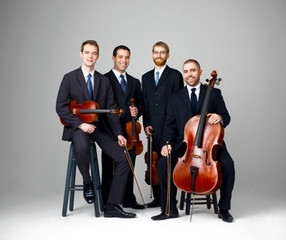|
Back
One Two Three Faux! New York
Advent Lutheran Church/United Church of Christ
09/15/2014 -
Music Mondays Concert Series:
Matthew Ricketts: After Nine: Fantasia on Mahler
Taylor Brook: Arrythmia
Gustav Mahler: Symphony No. 9 (Arranged by Klaus Simon)
JACK Quartet: Art Streisfeld, Christopher Otto (Violins), John Pickford Richards (Viola), Kevin McFarland (Cello) – Argento Chamber Ensemble: Lance Suzuki (Flute), Arthur Sato (Oboe), Alicia Lee, Pascal Archer (Clarinets), Nanci Belmont (Bassoon), Karl Kramer, Kyle Hoyt (Horns), Andy Kozar (Trumpet), Matt Ward (Percussion), Benjamin Ickies (Accordion), Joanna Chao, Philip Fisher (Piano), Doori Na (Concertmaster), Clara Lyon, Elissa Cassini, Anna Elashvili, Keats Dieffenbach, Patti Kilroy, Esther Noh, Karla Donohew (Violins), Stephanie Griffin, Angela Pickett, Vicki Powell (Violas), Michael Haas, Alistair MacRae, Joseph Lee (Celli), Michel Galante (Artistic Director/Conductor)

M. Galante (© Courtesy of the Artist)
Under a faux-ivory triptych of Jesus’ final hours, the Argento Chamber Ensemble and JACK Quartet played their own triptych of faux-Mahler’s final complete symphony last night. One piece was a “fantasia” on the Ninth Symphony, the second gave “winks” (the composer’s word) on the opening movement of the same symphony, and the third work was the complete Ninth, though–in ungilding the lily–re-orchestrating the piece for a smaller orchestra.
The first two pieces were enigmatic and fascinating in their own right. So intricate and clever were they that I wished the Mahler quotes had been unexpected. Instead, like the children’s game of detecting animals in a blurred painting, we had the distraction of thinking, “Aha! There it is! I recognized that motive, that theme, those reflections.”
Matthew Ricketts’ punny After Nine (the after nine of a faun?) was not exactly a “fantasia” on Mahler. The string quartet, flute, clarinet, percussion and solo piano (played wonderfully by Joanna Chao) essayed into an uninterrupted trip of moods more than themes, though the opening drooping F-sharp-E motif was always present. Mahler was more recognized in the structure than the melodies. We had soft harmonies building into Mahler-like grand climaxes, full orchestral ensembles leading to hushed soprano measures (a beautiful one of piccolo, tiny cymbal and piano in the upper register).
Michel Galante, the Artistic Director and Conductor of Argento, never ceases to amaze with his mastery of these scores, and without a baton–he changes from stick to mere fingers at a whim–he charged the group with playing Mr. Ricketts’ always dynamic score. The final drooping minor second was the ideal ending.

JACK Quartet (© Henrik Olund)
Like Argento, the JACK Quartet takes scores which seem unplayable and not only executes them, but gives them the most vibrant life and animation.
In fact, during Taylor Brook’s Arrhythmia, they added almost parodistic humor during the concentrated work. Where Mr. Ricketts went from mood to mood, beginning and ending with the infinity of silence, Mr. Brook obviously saw Mahler’s rhythmic possibilities. For the JACK Quartet presented a work whose volition, energy and pulsing power rarely stopped.
Oh, yes, a few moments were blatantly parodistic. First violin Art Streisfeld played a most beautiful sensuous solo, and then proceeded to give the schmaltziest reflection on that passage, a positively icky section, exaggerating Mahler’s own consciously mawkish string glissandi. Whether this was composer Brook’s inspiration or Mr. Streisfeld adding some cloying humor, I’ll never know. But it was a welcome burlesque in this very exciting score.
The real Mahler was the Ninth Symphony, arranged from one of several arrangements by the German music theorist Klaus Simon. He had made one chamber arrangement for strings, horns, percussion, flute, oboe, clarinet, bassoon, piano and harmonium. With another for solo instruments of each.
Argento had a “full chamber force” of strings (i.e., eight violins, three violas and celli and a double-bass), all those winds, sparingly used percussion, brass and piano. Instead of the harmonium, though, Benjamin Ickies, a master of his instrument played the accordion.
Now I confess to being an squeezebox squeezer myself, (akin to confessing being a serial murderer). So, while I could picture an accordion in the klezmer sections of Mahler’s First, I never imagined it here. Or at the most, it would simply be the musical equivalent of a cornmeal filling in a cheap crab cake.
Conductor Galante, though, explained that the replacement was because the accordion sounded more “vernacular” And Mr. Ickies, in one gorgeous solo in the first movement, and much doubling in the other movements, was unobtrusively excellent.
With musicians of the Argento class, one rarely missed the orchestral wonders of the Ninth. Though the piano ripplings hardly approximated the two harps of the original. And while the horns and trumpet were marvelous, that quartet of Mahler trombones had to be imagined.
Even more, in the first and final movements, the contrasts between full orchestra and the hushed meditations and chorales were unfortunately absent. Instead, those two movements showed the wonders of Mr Galante and the fine soloists, with some beautiful solos by violinist Doori Na and moving horn solos by Karl Kramer.
But Mahler’s second movement, with its reduced forces, had a more transparent velocity, not a distorted salon waltz, but an urgent fierce waltz which leaped out of a Berlioz hallucination. The Burlesque was made for solos rather than full orchestra, and Mr. Galante made the most of it.
Most memorable was a Mahler description told to Mr. Galante by musicologist Josef Horowitz. In describing the final symphonies of three grand Late Romantics, said Tchaikovsky’s Sixth was the melancholic composer looking down (to an Orthodox Hell). Bruckner’s final symphony was the composer looking up (to a Catholic Heaven).
“For this final symphony,” Galante quoted Horowitz, “Mahler was looking everywhere.”
Harry Rolnick
|